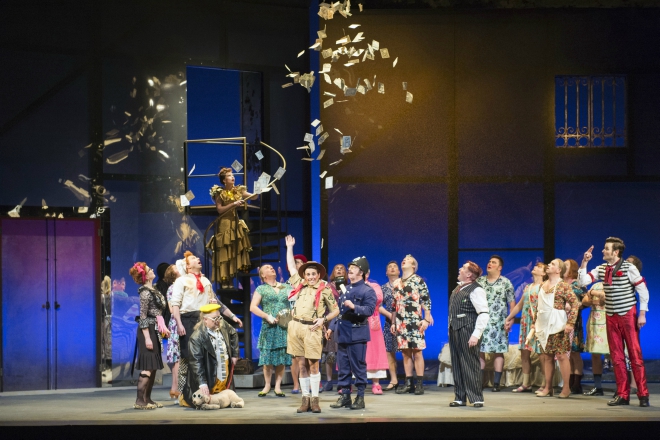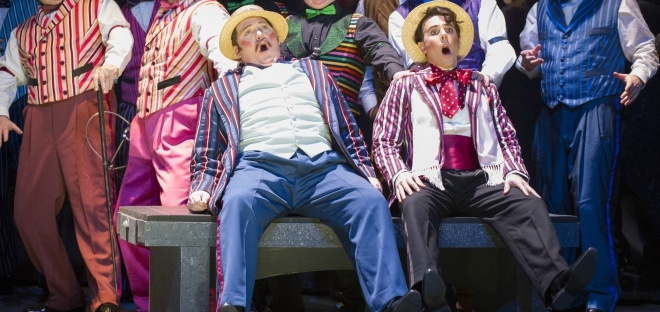[Cover photo: Richard Hubert Smith]
Since it’s now (somehow) 2016 and we’ve already made it through two months of the year (seriously, how did that happen?), it was about time I headed down to Cardiff Bay to see the wonderful Welsh National Opera. I had been waiting quite impatiently for their ‘Figaro Forever’ Season, having been intrigued by the promises of Mozart, world premieres and a famous one I had not seen (“Figaro! Figaro! Figaro!”). And, therefore, it was an absolute joy to be able to start my Figaro Adventure ‘at the very beginning’, as it were, with The Barber of Seville.
Welsh National Opera’s ‘Barber’ went above and beyond everything I had anticipated it to be. It was shamelessly hilarious. The setting of the overture – with it’s utterly distinctive tunes and driving force – was outstanding. Almost Disney’s Fantasia-like in quality, an absolutely inspired choice saw the pattering and snipping of the famous melody accompanied by a troupe of dancing scissors; this gloriously abstract image was a sheer delight and entirely entertaining. I couldn’t help but chortle aloud and we were only about three minutes into the opera.
On the whole, the opera got off to a brilliant start. The male chorus were wonderful, vibrant performers, and Fiorello (Howard Kirk) provided some great moments as a soloist. I felt it started going a little flat when Count Almaviva (Nico Darmanin) arrived on the scene; although his acting and general stage presence were spectacular (and he really did improve as the opera went on), the voice seemed to lack the punch I was expecting. This was one of my larger qualms with the production as a whole: the principal characters seemed to be a little too hit and miss with their vocal prowess on the night. It was mostly fine – especially since it was very clear that they were throwing themselves into the production with every fibre of their being – but some moments felt slightly underwhelming. I wondered if this was, in part, due to the decision to perform the opera in English. To me, the language didn’t seem to compliment Rossini’s vocal writing; the tongue-twisting nature of the word setting (hard enough in the original Italian!), meant that the delivery either came across as laboured or, occasionally, that the vocalists and orchestra got out of sync. Having very limited knowledge and experience of seeing Italian opera, I wasn’t certain whether this issue was a common feature of the genre (by the sheer merit of the music being fiendish) or whether this was simply a small problem in this production that will be tightened as the run continues on tour.
As with the rest of the cast, the tongue-twisters and speed of the music sometimes got the better of Figaro (Nicholas Lester), but this could not deter from the sheer force Lester brought to the character. He outshone everyone and through his every move became a demanding, significant figure, with his frequent abolition of the fourth wall (either by bounding through the audience with leaflets or giving a sarcastic aside) often being rightly greeted with laughter. He was utterly charming, and his physical presence – towering above the rest of the cast – was very striking; this aspect also provided comedy gold for whenever Figaro and the Count were standing side by side, their noted differences in height giving the impression of some sort of hilarious crime-fighting duo.

The set – designed by Ralph Koltai – was very impressive. It consisted of two enormous, movable panels, which were adorned with abstract gold patterns. I liked the way that light was reflected onto these panels and often created a shimmering effect that bounced around the theatre. The fact that the panels were slightly see-through was also really good, as I liked being able to see the characters approaching from upstage, and this often complimented the idea of them sneaking around. My only qualm with the logistics of the set was that there was a little too much unnecessary spinning of the panels; this did not occur to the point of being truly irritating, but sometimes felt simply a little pointless.
On the other hand, another memorable feature of the stage design, which I was very fond of, was an enormous wardrobe (a set feature that would return in later ‘Figaro Forever’ operas…) that the cast were often found clambouring into as a means of exit, giving the impression of going off on a comical adventure like some sort of Narnia-venturing pack of Pevensies.
‘Barber’ provided opportunities for some really striking images. As I’ve somewhat come to expect, the classic WNO slow-mo made an appearance, and, in this particular case, was hugely effective and very, very funny; the male chorus (dressed in drag and looking irate – see above photograph) were causing a ruckus by hitting each other with household utensils (shout out to the chaps with the saucepan and rolling pin).
Another stand-out moment was the scene with the extreme weather at the end of Act II. I was completely blown away by the staging of this scene, as well as the technical elements that were exploited to evoke this thunderstorm. It was slick, clean, and beautifully done and I was very impressed.
Overall, WNO’s first offering in the ‘Figaro Forever’ trilogy made for a great production – it had lovely design elements, beautiful staging, and a successful dramatic concept. It seemed to have all of the elements of a classic, with merely a few key features that could do with polishing; I would be intrigued to see it with a different cast of singers, since I was left wondering what difference this could make to the opera’s ability to flourish. With such a vibrant aesthetic, mixed with familiar music and a fun storyline, I also strongly believe this particular production would also make for a fantastic first opera. At any rate, it made me smile and laugh out loud a great deal (which makes a pleasant change!).
On my journey home, I met a couple of friends who I had not seen in quite some time and who had also happened to be at ‘Barber’ that evening. We got talking and I was delighted to discover that the evening marked their first experience of opera; what was even better was their admission that they had really enjoyed themselves. They seemed utterly in awe of the art form and the WNO singers, having been, in particular, completely blown away by the vocal talents of Claire Booth as Rosina. Having (quite rightly!) identified that ‘Barber’ was very amusing, they asked if comedy was unusual in opera; I enjoyed this question, and happily answered, ‘Not really!’. I explained that, much like any good story, opera is often full of the light and dark moments. They seemed pleasantly surprised by this fact and, after I explained to them that The Marriage of Figaro (which WNO were also presenting) was just as funny and musically accessible, they seemed pretty enthused to maybe go and check that production out too.
It’s great to see and hear that opera is still reaching out to new people, tempting new audiences and shaping new fans of the genre – congratulations to Welsh National Opera for playing a part in that process!
Figaro Forever:
- The Marriage of Figaro [link coming soon]
- Figaro Gets a Divorce [link coming soon]


2 thoughts on “17th February 2016 – ‘The Barber of Seville’, Welsh National Opera”